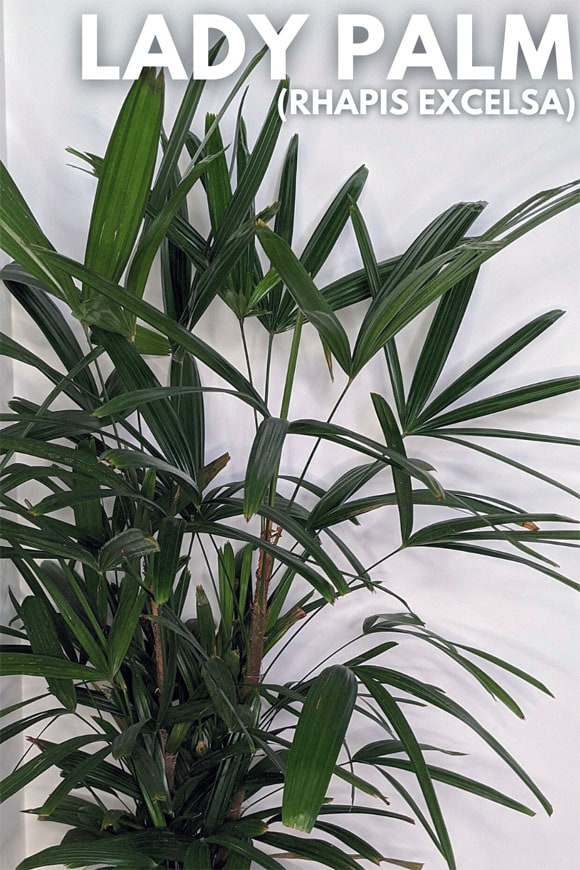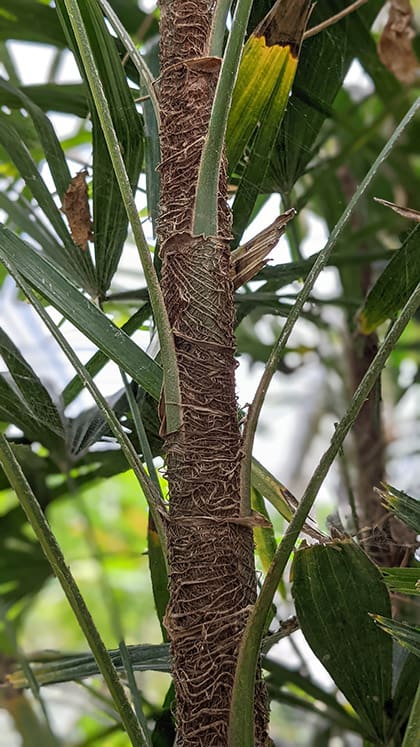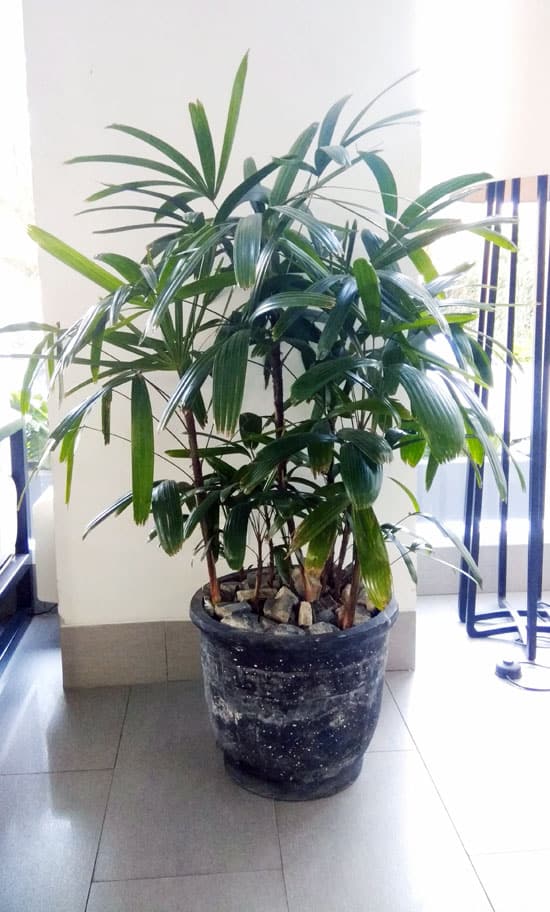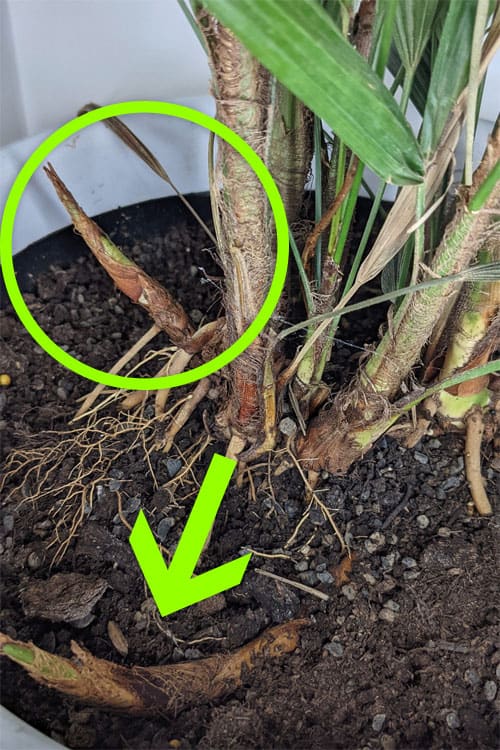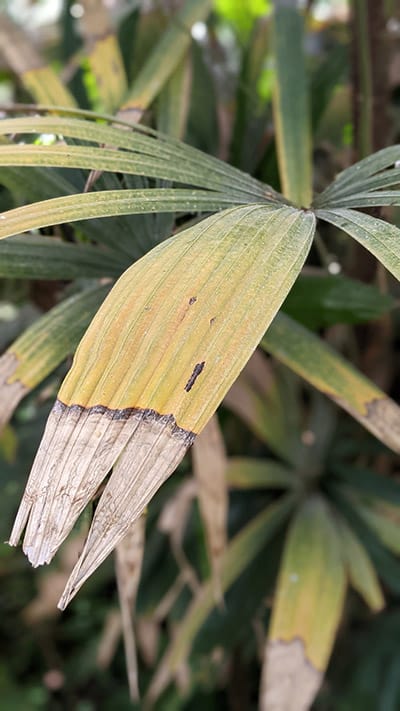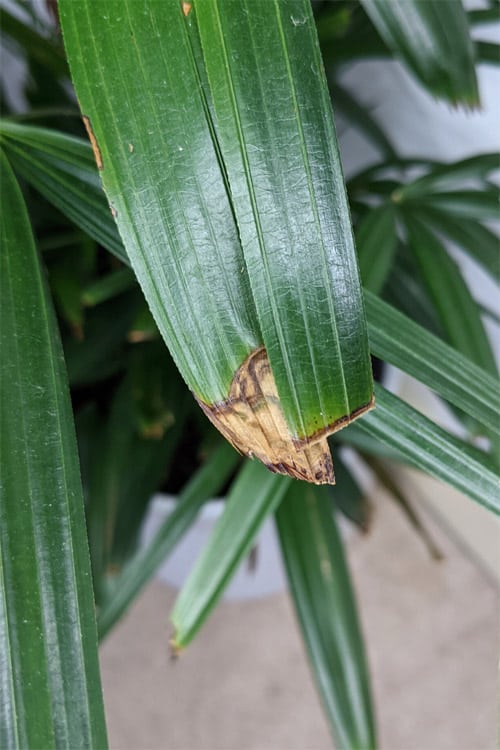Rhapis Excelsa or the Lady Palm is a less well known indoor houseplant. Its high price and slow growing nature seem to have put people off them in recent years, but I honestly believe they're a contender for the easiest indoor palm you can own.
With their upright and sturdy canes they're hardy and forgiving, even happy to put up with low-light conditions. Perfect for new plant parents and if you're a fan of the unusual growth habit and tropical appearance they'll fit right into your home.
The dark green leaves are glossy and fan-shaped. They'll divide into four or more segments and the tips end in a toothed edge. Very unique looking houseplants.
How do you pronounce Rhapis Excelsa correctly? Say:
RAY-piss eck-SELL-suh
It's not a difficult houseplant to keep. Actually, it's one of the easiest and most forgiving plants I've ever owned.
It puts up with some pretty dark and dim spaces, seems both resilient and resistant to the majority of pests and the stems and roots are vigorous enough to put up with relatively minimal care with no adverse effects.
The worst thing it does is "wilt" and "flop" a little when it's thirsty (which is actually pretty helpful as it prompts me to water it when I've forgotten about it!) and occasional brown leaf tips, caused by my underwatering.
They were part of NASA's air cleaning experiments (coming in second place) and the RHS in the UK gave it their Award of Garden Merit.
The various common names it often goes by come from how the plant looks. Here's a quick explanation.
"Lady Palm"
Each leaf is divided into broad segments ending in blunt tips. Young plants will produce just a few leaf segments per stem, but this increases to five or more as the plant matures. This appearance can look like a flat "hand" with it's fingers spread.
"Broadleaf Lady Palm"
The same as above, except the "broadleaf" is added to describe how broad the leaves are, compared to other palms.
"Bamboo Palm"
New foliage emerges from the base of the plant, which is wrapped in a brown fibrous sheath. The sheath eventually starts to come apart and this, blended with the look and markings on the stem underneath, has a Bamboo like quality.
Photo showing the bamboo like sheath on a Lady Palm tree.
Let's talk about availability
In reality, different cultivars are even less popular and well known in Western Countries. I think you'll struggle to find any variety other than the standard all green type in average houseplant shops so if you want one of these, you may need to seek out a specialist seller.
Although they were originally cultivated in China, the Japanese really liked these plants and have created several cultivars over the years. These differences mainly focus on variegation or the overall size.
Rhapis Excelsa 'Zuikonishki' / 'Chiyodazuru' are variegated with light green or cream stripes running through the leaves.
Rhapis Excelsa 'Koban' - This is a dwarf variety. Very slow growing and the leaves grow tightly together, creating a full and bushy look.
There are two main reasons for their price point. Firstly even if you provide ideal growing conditions these are seriously slow growing plants. The nursery will need to raise them for at least four years before they're a decent size and ready for sale. That's at least four years of someone's time and resources that need to be paid for.
Secondly, they're sort of "rare" plants. You won't find them for sale in many garden centers or nurseries. This is partly because there isn't a huge demand for them (at the moment).
This surprises me because, as mentioned already, the Palm is hardy and very tolerant of most indoor conditions, more so than many other palms grown as houseplants. So even if you only have a little green thumb, there is no reason why this plant couldn't be with you for ten years or more - potentially making it an excellent investment.

Hi, I'm Tom!
If you're like me and enjoy the challenge of growing houseplants and getting them to thrive, then Ourhouseplants can help. This website shares my knowledge and years of growing plants and provides (hopefully) helpful advice on properly caring for your indoor plant friends.
They really want the classic "bright indirect light," which means the brightest spot you have in your home without being bathed in intense sunlight (too much sun can cause yellow leaves).
If you can provide this you'll get a few inches of growth over an entire growing season, along with one or two brand new stems emerging from the soil.
If those "bright indirect light" spots are already reserved for the more fussy houseplants in your collection, then the Lady Palm will put up with lower light conditions pretty well. You won't get as much growth (if any), but the plant won't die on you either.
Rhapis Excelsa in a hotel lobby - Photo by Aris riyanto
Again this is a tolerant indoor plant. It will take sporadic watering in its stride. But be kind and try and give it what it wants by soaking the soil and then waiting until the surface and top inch have dried out. It likes this type of watering style all year round.
Top Tip
If it's being grown in a warm room you can expect these plants to be pretty thirsty and needing regular watering.
If you underwater and let the entire growing medium fully dry out, the plant will start to flop a little. It's not as obvious as what happens with the Peace Lily or Nerve Plant but you can definitely see it happening. Don't wait much longer after you see this warning sign or you may get brown ends forming on the tips of the leaves.
Overwatering is the bigger threat as excessive and prolonged waterlogging around the roots, especially in winter, can trigger root rot and severe damage to the plant. Mild overwatering constantly can cause black leaf tips.
Although they're tropical plants, the Lady Palm can cope well with either low or high humidity levels.
It's a slow grower so it'll never grow that fast, even in the very best growing conditions. This means the need for feed is on the low side.
I fertilize mine with a basic all-purpose feed three times a year. Once in Spring, Summer and then early Autumn. That's it. Don't overdo it, because overfeeding can cause black leaf tips and edges
Try to grow it somewhere all year round with a temperature range between 10°C (50°F) and 25°C (77°F).
A Rhapis palm is normally hardy too, so will be able to withstand a slight chill every now and again, but the foliage is easily damaged. So even if the plant itself survives, the foliage (which we've already established is slow growing) could become tatty looking.
Compared to many palms, the roots on Rhapis are pretty thick and grow vigorously. In my experience, they also don't seem too phased by repotting. That said, they're also happy to grow in the same container for several years so it's not an urgent requirement to do it.
I'd consider looking to repot every three or four years, increasing the pot size as you go. But you could do it sooner if the roots are distorting the container, or you can see them coming out of the pot's drainage holes.
Root rot is the only real major problem with these plants. So reducing the risk of that happening will only be a good thing.
Make sure your pot has at least one drainage hole at the bottom and use loamy soil or a free-draining potting soil if you can, to let excess water drain away. If you can't get this soil type where you are, just make sure you add materials to help keep the mix open and airy, such as grit or perlite.
These palms hardly ever flower indoors and you need a male and female plant close by, so the chances of getting your own seeds to create new plants is pretty low.
Instead what you can do to propagate more plants is to either divide the clump or remove any spreading rhizomes to create a separate plant to grow on.
The spreading rhizome offshoots shown, are a great way to propagate more plants
In the photo above there are two visible rhizomes or "runners". One is shown in the circle and the other is shown by the arrow.
You can remove both of these from the mother plant, but I'd personally leave the one in the circle as it's growing so close to the existing stems. Over time it will grow upwards and help bulk out the main plant.
The runner shown by the arrow is ideal for propagating a new plant. You can trace it back to the established stems and this will have its own root system just under the soil.
All you need to do is cut it back somewhere close to the existing clump. Gently pull it out along with it's roots and you'll have a "cutting" to pot up and grow on. Use a similar soil mix to whatever it was growing in before.
Although it has a slow growth rate, with proper care and good levels of light, you should still get at least a few inches of upwards growth a year and one or two runners appearing around the base of the plant.
If the care it's getting is reasonably poor, or you're growing it in a low light position, you will only get a minimal level of growth (or none at all!).
Most indoor plants will never be taller than 2m / 6ft and new plants could take almost a decade to get to that height.
I have a care guide on YouTube if you'd like to see live footage of my plant.
It's very rare for indoor palms to flower although not unheard of on a mature plant. This is another houseplant grown for its look rather than any blooms it may produce.
There have been no reported cases of toxicity issues with this plant. So yes it's safe to have around pets. The bamboo-like trunks might attract cats looking for a scratching post!
Along with occasional gone over lower leaves or stems, dusty leaves are the only other maintenance issue to deal with. The dust dulls the natural shine and prevents light from reaching the leaves.
The Solution
Clean or wash the leaves every couple of months.
Pests
I've only ever had two issues with insect pests during my ownership. These were Thrips (Thunderflies) and Mealy Bugs. There wasn't a huge number of either pest and I'm not sure if I caught the problem early or they just don't find the plant to be particularly habitable.
In both cases I mixed up a simple Neem Oil spray as detailed here and one treatment was all that was necessary and no issues since.
You could probably try a mild insecticidal soap and wipe the leaves down with a damp cloth for similar results if you don't have any Neem to hand.
Spider Mites and Scale Insects could in theory be a problem too and Neem Oil might not be enough to deal with these. If you get these pests then look into a systemic insecticide to help get rid of them for good.
Yellow Leaves
This can happen with overwatering, but receiving too much light from full sun can also cause this to happen. So make sure you have good drainage around the root ball and avoid intense direct sunlight falling on the glossy green fronds.
These yellow leaves can be caused by several things, including overwatering, Underwatering and also extreme sunlight.
No Growth
Indoor growing conditions with mid to low light levels, combined with this plant's slow-growing nature mean that many owners could expect little to no growth. Sure, they'll survive lower lit spots, but they really need a bright growing area for growth.
Brown leaf tips
Brown leaf tips on this Lady Palm plant caused by underwatering. You can snip the brown bits off to improve the look.
Brown tips are probably the most common problem owners will come across. Usually caused by one of the following.
Black leaf edges
Black leaf edges can be a sign of any of the following.
Root Rot
I've found that this plant will cope with drought and some overwatering quite well. However, during one Winter I did overwater quite heavily without realising. This combined with lower temperatures and even less light resulted in a section of the plant on one side going brown and dying off.
When I investigated, some of the roots towards that side had rotted.
I removed as much of the rotting roots as I could (it all came away quite easily to be honest). I replanted the remainder of clump which eventually produced some new growth and it's recovered without further problems.
I'd never heard or seen this palm at all, and only came across it by chance in a large supermarket chain of all places.
A few feet tall and quite expensive considering what plants they normally sell. These fan palms caught my eye and when I went back a couple of weeks later, a few were still being sold so I snapped one up.
This was a few years ago now and since then it's grown a little bit. Nothing too impressive growth wise but I'm still astounded by it.
It's a total recommended plant from me. Possibly one of the easiest palms I've ever owned.
It's survived (and still grown a little) despite me putting it in one of the lowest light locations in my home. Even Sansevieria's struggle in this particular spot and refuse to grow, whereas this has put up with the low light, a small infestation of mealy bugs and regular underwatering.
Yet it's still given me a new stem and several shoots. I'm so impressed with its cast iron nature.
The overall look of this plant with the wide segments and tall stalks are unusual, so I get some people won't like how it looks The cost to buy it will put some off right away too.
That said, I feel it's a good value plant and a great choice especially for any plant parents who want something forgiving. It's a total recommended plant from me.
